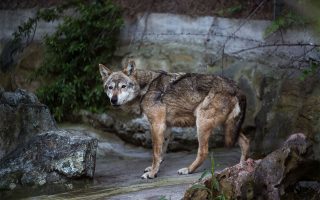The uneasy return of the wolf to Mt Parnitha
Experts outline challenges of wildlife-human coexistence in peri-urban areas and recommend what action is needed

The re-emergence and stabilization of the wolf population on Mount Parnitha, on the northwestern outskirts of Athens, in recent years is an important development, which on the one hand demonstrates the force of nature but, on the other, creates new challenges in the management of a mountainous national park situated next to a populous capital city.
The first packs of wolves were detected on Parnitha in 2014, 60 years after their disappearance from the mountain and many other areas of southern Greece. According to biologist Giorgos Iliopoulos, who specializes in wolf ecology and conservation, there are four groups of wolves in Parnitha today, with a total population of 30 to 40 individuals.
What is the reason for their reappearance, considering that the wolf does not change territory easily? “One reason is that the animal came under pressure in another areas. From there on, enormous changes that have taken place on Parnitha in recent years played a role. Parnitha used to be an inhabited mountain, with a multitude of economic activities taking place. These activities have now been abandoned, so the wolf – and other species of animals – found more room to thrive,” says Giorgos Chatzinakos, a human geographer and a member of Human Dimensions, a group within the environmental organization Callisto.
“At the same time, Parnitha experienced an identity shift. It was ‘rediscovered’ by Athenians during the debt crisis and the [Covid-19] pandemic, so again, it is a changed mountain, with traffic jams on the weekends and mounds of trash. Unfortunately, there is no public information and awareness about the rules of visiting a national park and a mountain, for example, that you are not allowed to have a pet with you. There is no information center [to explain] about how to act, what to do with your garbage, not to be afraid, but to respect nature,” Chatzinakos tells Kathimerini. The wolf, meanwhile, is at the top of the food chain in Parnitha’s animal kingdom. “It regulates other populations, like deer. The wolf avoids man,” he adds.
Cases of wolf attacks on humans are so rare that only two human deaths from wolves in Europe and North America have been recorded in the last 40 years. At the same time, however, as many houses are springing up around Parnitha and the number of visitors to the mountain is also increasing, there is a need to train state agencies and the public, as well as to create a plan for managing the wolf population.
The European “Life Wild Wolf” project aims to implement actions that will facilitate the coexistence of humans and wolves in forests near cities. As stated by NGO Callisto, which is implementing the program in Greece, the goal is to achieve a balanced and long-term conservation of the wolf population in the greater urban areas of eight countries in southern and central Europe (Greece, Germany, Italy, Croatia, Portugal, Sweden, Slovenia and the Czech Republic) by improving the technical and operational capacity of competent authorities to manage and prevent human-related conflicts. At the same time, it encourages sustainable practices that preserve the wolves’ wild nature and improve people’s ability to deal with any problems they may create create.
“We want to improve people’s relationship with wildlife and their natural surroundings. We work in a collective framework to involve local communities in a process of social learning,” Chatzinakos says.
The Parnitha Coexistence Platform is one of the results of this philosophy, a joint effort between Callisto, the Environment Ministry’s Natural Environment and Climate Change Agency (OFYPEKA), the Municipality of Acharnes and the Forest Service, which is organizing open meetings, hoping to involve citizens.
“There are many small and big issues that need to be discussed. One important issue is the large number of stray dogs that are abandoned on the mountain. Apart from attacks, these dogs can mate with wolves and create hybrid species, which are also wild but more familiar with humans. We also need to be careful not to leave trash and leftovers outside and within reach, because it makes wolves come closer and become accustomed to the presence of humans,” Chatzinakos adds.

Dialogue and proposals
A workshop was held in the spring at the Acharnes Mountaineering Association sports center, titled “The wolf of Parnitha from a different perspective: An open dialogue on the coexistence of humans and wildlife.” The impressions recorded are interesting. Asked what the presence of the wolf in Parnitha means, attendees showed a mix of both positive and negative feelings. Some expressed joy and hope for the recovery of the ecosystem, excitement at the opportunity to learn and understanding for the need to coexist with wildlife, as well as feelings of respect and awe for the wolf. Some also spoke of the need to be alert to the danger of criminal reactions by humans, such as the use of poisoned bait. Others, meanwhile, lamented that the return of the wolves means that people have abandoned the mountain, expressed concern about pressure on the deer population and fear for human safety. The need for more awareness of the rules that visitors must adhere to when visiting the national park was also spoken of, as was an interest in addressing wolf myths that fuel public concerns.
‘We want to improve people’s relationship with wildlife and their natural surroundings. We work in a collective framework to involve local communities in a process of social learning’
The proposals that have been submitted for facilitating the coexistence of humans and wolves on Parnitha included the need for sustainable management of the forest, for better monitoring of the wolf population with the assistance of those who visit the mountain regularly or love/work there and improving visitor awareness through the Parnitha Management Unit, among other measures. Participants also noted that it is important to inform what they should (or should not) do in a national park – and particularly that they should not feed wildlife.
The overarching message is about an attitude that integrates humans into the ecosystem rather than pitting them against it.
Action plan needed
A debate is under way in the European Union regarding the legal status of the wolf, with proposals to reduce its level of protection, a move which, however, is meeting with strong opposition from environmental organizations. But for Greece, especially, organizations involved in the conservation of wildlife consider that there are additional reasons not to change the definition of the species as protected. Firstly, its population concentration, despite the significant recovery of recent decades, still cannot be regarded as satisfactory. Secondly, Greece is one of the few European countries that still does not have an action plan for the wolf. The action plan is essential for addressing the conflicts between the animal and human activities and to specialize wolf management geographically and on a case-by-case basis. There are fears that a relaxation of its protected status will lead to an increase in mortality caused by humans.
What’s more, the wolf, as an apex predator, plays an important regulatory role in wildlife populations, such as wild boar, which in many areas of Greece have greatly increased, causing havoc and creating hazards on the road network. There are, of course, complaints of wolf attacks by farmers, who are under pressure from a number of different factors (rising prices of feed, market control by oligopolies, etc.). According to a study by Giorgos Iliopoulos, in which the biologist cites data from the Hellenic Agricultural Insurance Organization (ELGA), wolf attacks on sheep and goats have decreased significantly, in part because sheep and goat farming in Greece has also dropped. On the other hand, attacks on cattle are increasing, as their number grows, while in some cases there is insufficient implementation of preventive measures. The upgrading of these measures, as well as the payment of fair compensation to livestock farmers, are considered necessary measures.
The ‘big, bad wolf’
“The big bad wolf” is one of the most frequent metaphors, used in fairy tales, narratives, oral speech and literature. “The wolf has been cast as the ultimate evil, in the most absolute, persistent, frequent metaphor that appears in human discourse,” Electra Lazar, author of the book “Wolf, Wolf, Are You Me?,” tells Kathimerini.
“The wolf as a metaphor in public discourse is a complete departure from the real wolf. It is a human construct, endowed with human characteristics, which have nothing to do with its true nature. It appears as a non-wolf. For example, when the wolf is trying to survive and needs food, it is presented as bloodthirsty,” says Lazar, pointing to a ubiquitous depiction.
According to the author, the wolf is among the most prevalent creatures in human lore and literature, even more so than the lamb, the dove or the raven. And it is also burdened with an extremely negative image. “The bear, for example, has been associated with sweet honey, even though bears were held captive and tortured for many years with copper rings in their noses to entertain people.”
The animal is used even in propaganda. In her book, Lazar cites and comments on propaganda images from the Second World War, where all warring sides present their opponents as wolves, i.e. as the ultimate evil.
Where does this negative image come from? “It has deep roots and a complicated path. In ancient folk tradition there is the negative metaphor of the wolf, with Mormo [a female specter in Greek folklore, used to frighten children into submission to discipline] transforming into Mormolyke [Wolf-Mormo]; Homer’s Lyssa is a female wolf; the Roman Lupercalia; there is the myth of King Lycaon, and so on. These references also propagated the notion that the wolf is something elusive and untouchable. That it is a psychopomp, that it has a connection with the other world. The Christian Church further propagated such symbolisms, and even more so the extermination of the wolf,” notes Lazar. “There are many references in the Bible, like the nocturnal presence that eats the lamb, the devil’s dog, a demonic creature. These perceptions were largely shaped in the third century, when Christians became influenced by their first sight of the huge animal-like Egyptian deities, which filled them with awe and fear.”
These metaphors continued in the Middle Ages, where the terrifying dark forest became a popular theme. “People were accused of being werewolves simply because they lived alone in the forest,” Lazar says.
And now? “The wolf had disappeared from Greece and much of Europe for decades and now that it is reappearing, now that it is coming out of the book and into life, we are unprepared for it. The European Union, in fact, jumped to allow the resumption of wolf hunting,” the author says. “In Parnitha, the urban world is invading the natural one, without harmonizing with it. The urban world does not conform, it wants to impose itself on nature, which is a habitat for so many other species.”
Are there problems and conflicts stemming from the presence of wolves? “I understand the challenge for the farmer, who struggles for a livelihood and may see his flock wiped out with the arrival of the wolf. But there are answers other than hunting,” says Lazar.
Has there been a small shift in the traditional metaphor of the wolf in contemporary discourse? “The context in which the wolf is portrayed is so set in stone that we can only speak about small shifts. But yes, they exist, even in children’s fairy tales, as well as in literature. And they come mostly from books by women writers, who have a minority heritage, a background of displacement,” Lazar explains. “It takes reading, education and a lot of effort to gain respect for wildlife and the wolf.”





